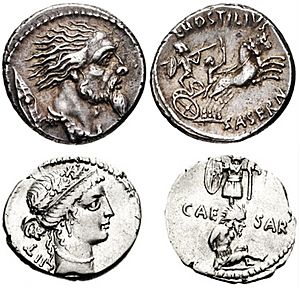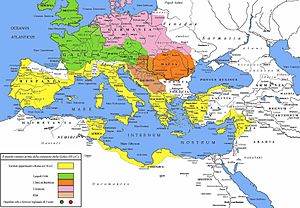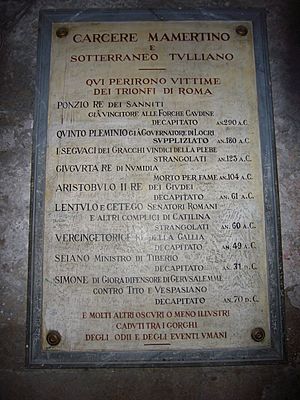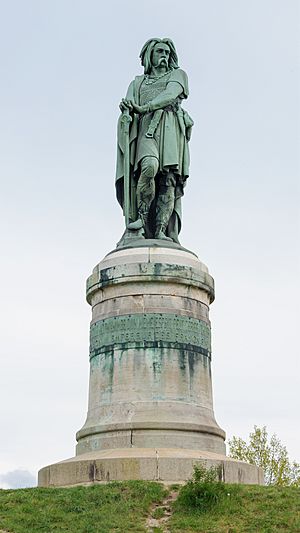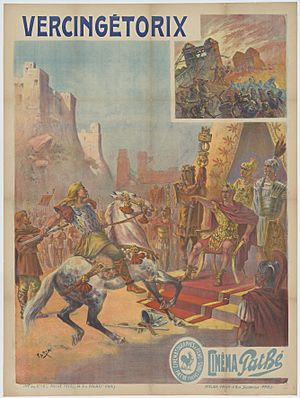Vercingetorix facts for kids
Quick facts for kids
Vercingetorix
|
|
|---|---|
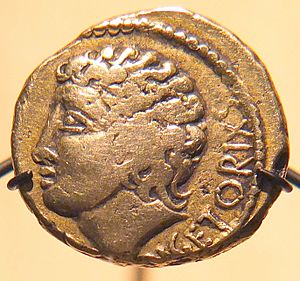
Gold stater of Vercingetorix, Cabinet des Médailles. This depiction is idealized and symbolic.
|
|
| King of the Arverni | |
| Personal details | |
| Born | c. 80 BC Unknown |
| Died | 46 BC (aged 36–37) Rome, Italy, Roman Republic |
| Cause of death | Execution |
Vercingetorix was a brave Gallic leader and king of the Arverni tribe. He brought together many Gallic tribes to fight against the powerful Roman army. This happened during the final part of Julius Caesar's Gallic Wars.
Even though he bravely fought the Romans, Vercingetorix eventually surrendered to Caesar. He was later executed in Rome.
Vercingetorix was the son of Celtillus, who was also a leader of Gallic tribes. Vercingetorix became the chieftain of the Arverni tribe in 52 BC. This happened at a place called Gergovia. He quickly formed alliances with other Gallic tribes. He took command of their combined forces. He led them in the biggest revolt the Celts had ever launched against Roman power.
He won an important victory at the Battle of Gergovia. In this battle, thousands of Romans and their allies were defeated. The Roman armies had to retreat.
Caesar had been able to conquer Gaul easily before. He used a strategy of dividing the Gallic tribes. Vercingetorix's effort to unite the Gauls against the Romans came a bit late. At the Battle of Alesia, also in 52 BC, the Romans surrounded and defeated his forces. To save his men, Vercingetorix gave himself up to the Romans. He was held prisoner for five years. In 46 BC, he was paraded through the streets of Rome as part of Caesar's victory celebration. After this, he was executed. Vercingetorix is mostly known from Caesar's own writings, called Commentaries on the Gallic War. Today, he is seen as a hero in France, especially in his home region of Auvergne.
What Vercingetorix's Name Means
The name Vercingetorix comes from the Gaulish language. It means 'great king of warriors' or 'supreme leader of heroes'.
The name is made of three parts:
- ver- means 'over' or 'superior'.
- -cingeto- means 'warrior' or 'hero'.
- -rix means 'king'.
So, his name itself sounded powerful and inspiring.
Vercingetorix's Story
Gaul Before the Revolt
In 58 BC, Julius Caesar became the Roman governor of a region called Gallia Narbonensis. This area is now part of modern Provence in France. Over the next few years, Caesar began to conquer the other Gallic tribes. He kept control by using a clever strategy. He would keep the Gallic tribes divided.
Caesar used the disagreements among Gallic leaders. He would support some noblemen over others. He also offered them Roman luxuries like wine. Before Vercingetorix, attempts to revolt, like one by Ambiorix in 54 BC, only got local support. Vercingetorix's father, Celtillus, had been killed by his own people for trying to rule all of Gaul. But Vercingetorix managed to unite the Gallic tribes against the Romans. He also used new ways of fighting.
How Vercingetorix Rose to Power
The revolt that Vercingetorix led started in early 52 BC. At this time, Caesar was busy gathering troops in Cisalpine Gaul. Some Gallic tribes, the Carnutes, thought Caesar would be distracted. There was trouble in Rome after a leader named Publius Clodius Pulcher died. So, the Carnutes attacked and killed Romans living in their land.
Vercingetorix was a young nobleman from the Arvernian city of Gergovia. He encouraged his followers to join the revolt. However, Vercingetorix and his supporters were initially kicked out by his uncle, Gobanitio. Other nobles thought fighting Caesar was too risky. But Vercingetorix did not give up. He gathered an army of common people. He took control of Gergovia. There, he was declared king.
Uniting the Gallic Tribes
Vercingetorix then formed alliances with other tribes. By doing this, he united Gaul. His goal was to free them from Roman rule. He was given supreme command of all their armies. He enforced his authority with strict rules. He also took hostages to ensure loyalty. This level of leadership and unity was new for Gaul. It would not happen again for many years.
He decided to use a strategy of retreating to natural strongholds. He also used a "scorched earth" tactic. This meant burning towns and farms. This prevented the Roman legions from getting food and supplies from the land. Vercingetorix burned much of the land as he marched north from Gergovia. This was to stop Caesar's army from finding resources.
The Siege of Avaricum
However, the capital city of the Bituriges, called Avaricum, was spared. This city was directly in Caesar's path. The people of Avaricum strongly protested against burning their city. It also had strong natural defenses and man-made walls. So, Vercingetorix decided not to burn it. He left the city to its fate. Vercingetorix camped far from Avaricum. He focused on attacking the Roman units led by Caesar.
When the Romans reached Avaricum, they began a siege. They eventually captured the city. After 25 days of hunger and hard work building siege equipment, the Romans took revenge. They killed almost everyone in the city, about 40,000 people. Only about 800 survived.
Battle of Gergovia
The next big battle was at Gergovia. This was the capital city of the Arverni. In this battle, Vercingetorix and his warriors defeated Caesar's legions and their allies. They caused heavy losses for the Romans. Vercingetorix then decided to follow Caesar. But he suffered heavy losses in a cavalry battle. He then retreated to another stronghold, Alesia.
The Battle of Alesia
In the Battle of Alesia in September 52 BC, Caesar built strong defenses around the city. He wanted to besiege it. But Vercingetorix had called his Gallic allies to attack the Romans who were surrounding Alesia. These forces included an army led by Vercingetorix's cousin, Vercassivellaunos. Another army of 10,000 Lemovices was led by Sedullos.
The Romans were surrounded by the rest of Gaul. So, Caesar built another set of defenses facing outwards. This was to protect against the expected relief armies. This created a doughnut-shaped fortification. The Gallic relief armies arrived, but not in enough numbers. Estimates say there were between 80,000 and 250,000 soldiers. Vercingetorix, the main leader, was trapped inside Alesia. Without his guidance, the attacks from outside were not successful at first. However, the attacks did find a weak spot in the Roman defenses. The combined forces inside and outside almost broke through. Only when Caesar himself led his last reserves into battle did the Romans finally win. This battle was a major turning point in the creation of the Roman Empire.
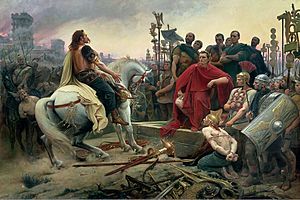
According to the historian Plutarch, Vercingetorix surrendered in a very dramatic way. He rode his beautifully decorated horse out of Alesia. He rode around Caesar's camp. Then he got off his horse in front of Caesar. He took off his armor and sat down at Caesar's feet. He stayed there without moving until he was taken away. However, Caesar's own writings describe Vercingetorix's surrender in a much simpler way.
Vercingetorix's Imprisonment and Death
Vercingetorix was held prisoner in the Tullianum prison in Rome. He stayed there for almost six years. In 46 BC, he was publicly shown in the first of Caesar's four victory parades, called triumphs. After the triumph, he was killed at the Temple of Jupiter Optimus Maximus. A plaque in the Tullianum prison says he was beheaded in 49 BC.
Vercingetorix's Legacy
Memorials and Statues
In 1865, Napoleon III ordered a 7-meter (23-foot) tall Vercingétorix monument to be built. The sculptor was Aimé Millet. It was placed at the supposed site of Alesia. The architect for the memorial was Eugène Viollet-le-Duc. The statue still stands today. The words on its base, written by Viollet-le-Duc, copy a famous statement by Julius Caesar. In French, it says:
Gaul united, Forming a single nation Animated by a common spirit, Can defy the Universe.
Many other large statues of Vercingetorix were built in France during the 19th century. One famous one is by Frédéric Bartholdi (who also designed the Statue of Liberty). It stands in the Place de Jaude in Clermont-Ferrand.
Other Tributes
- Asteroid: An asteroid named 52963 Vercingetorix was discovered and named in his honor.
- Comics: Vercingetorix appears in flashbacks in several Asterix comics. The comic Asterix and the Chieftain's Shield is about finding his missing shield. He is also a main character in the 18th book of The Adventures of Alix series.
- Film: The 2001 film Druids stars Christopher Lambert as Vercingetorix. It shows his fight against Caesar.
See also
 In Spanish: Vercingétorix para niños
In Spanish: Vercingétorix para niños


